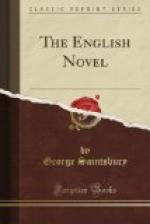She had even been preceded in the new line by one, and closely followed by another writer of her own sex, both of unblemished reputation, and perhaps her superiors in intellectual quality and accomplishment, though they had less distinct novel-faculty. Sarah Fielding, the great novelist’s sister, but herself one of Richardson’s literary seraglio, had a good deal of her brother’s humour, but very little of his constructive grasp of life. David Simple (1744), her best known work, the Familiar Letters connected with it (to which Henry contributed), and The Governess display both the merit and the defect—but the defect is more fatal to a novel than the merit is advantageous. Once more—if the criticism has been repeated ad nauseam the occasions of it may be warranted to be much more nauseous in themselves—one looks up for interest, and is not fed. “The Adventures” of David—whose progeny must have been rapidly enriched and ennobled if Peter Simple was his descendant—were “in search of a Friend,” and he came upon nobody in the least like O’Brien. It was, in fact, too early or too late for a lady to write a thoroughly good novel. It had been possible in the days of Madeleine de Scudery, and it became possible in the days of Frances Burney: but for some time before, in the days of Sarah Fielding, it was only possible in the ways of Afra and of Mrs. Haywood, who, without any unjust stigma on them, can hardly be said to fulfil the idea of ladyhood, as no doubt Miss Fielding did.
There is an amusing and (in its context) just passage of Thackeray’s, in which he calls Charlotte Lennox, author of The Female Quixote (1752), a “figment.” But it would be unlucky if any one were thereby prevented from reading this work of the lady whom Johnson admired, and for whom he made an all-night orgie of apple-pie and bay-leaves. Her book, which from its heroine is also called Arabella, is clever and not unamusing, though it errs (in accordance with the moral-critical principles of the time) by not merely satirising the “heroic” romances of the Gomberville-La Calprenede-Scudery type, but solemnly discussing them. Arabella, the romance-bitten daughter of a marquis, is, for all her delusion, or because of it, rather a charming creature. Her lover Glanville, his Richardsonian sister, and the inevitable bad Baronet (he can hardly be called wicked, especially for a Baronet) are more commonplace: and the thing would have been better as a rather long nouvelle than as a far from short novel. It alternately comes quite close to its original (as in the intended burning of Arabella’s books) and goes entirely away from it, and neither as an imitation nor independently is it as good as Graves’s Spiritual Quixote: but it is very far from contemptible.
Yet though the aptitude of women for novel-writing was thus early exemplified, it is not to be supposed that the majority of persons who felt the new influences were of that sex. By far the larger number of those who crowded to follow the Four were, like them, men.




